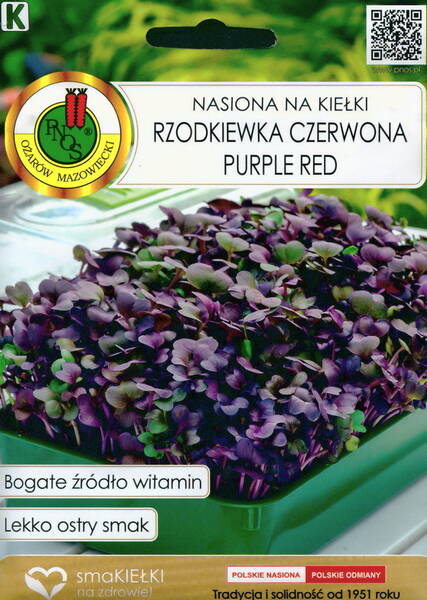A great source of vitamins for the winter period in Estonia!
A variety of leaf radish with a spectacular appearance and taste. The sprouts are purple, with green tints.
A fast-growing green crop (6-7 days), forming red-purple leaves, which are eaten fresh: in meat and fish dishes, in egg and cottage cheese dishes.
Ideal for salads, soups, vegetable dishes, appetizers, sushi and sashimi. The microgreens of this radish have a delicate taste, reminiscent of an adult plant. Gives a feeling of satiety for a long time.
1.0 g = 64-70 seeds.
Nutritional value of the product: 100 grams of purple radish contain 20 Kcal.
Proteins - 1.2 g.
Fats - 0.1 g.
Carbohydrates - 3.4 g.
General instructions for growing microgreens: pour the required amount into a bowl of room temperature water and leave for 8-10 hours.
Then place the seeds in the sprouter, covering no more than 25% of the tray, depending on the size of the seeds. Place the sprouts in a bright place at room temperature, changing the water 2-3 times a day.
The sprouts will be ready in about 6-10 days. Cut the sprouts near the surface of the soil and wash them before eating. They will keep in the refrigerator for up to 8-10 days.

PROPERTIES OF RED-LEAFED RADISH FOR SPROUTING.
Being an excellent source of folic acid in combination with vitamin B6, red-leafed radish sprouts promote healthy functioning of the cardiovascular system by destroying homocysteine, an amino acid, the excess of which is believed to lead to atherosclerosis.
Thanks to the rich set of phytoncides in the sprouts of this radish, a significant strengthening of the immune system is achieved. Their use gives vigor and has a general strengthening effect on the body. They are useful for diabetes and gout.
Sprouts and microgreens of leafy radish help in weight loss, they create a feeling of satiety, thereby reducing the amount of food consumed. Sprouted radish seeds are very low in calories and, together with an abundance of vitamin C and enzymes, they convert fats into energy.
In addition, vitamin C promotes collagen production, which maintains the smoothness and elasticity of the skin. Leafy radish also stimulates the liver and gallbladder, helps detoxify the body. The plant estrogens it contains strengthen women's health and help relieve the symptoms of PMS, menopause, hot flashes and fibrocystic diseases.
NUTRITIONAL VALUE.
Radish microgreens are a rich source of vitamins (A, B1, B2, B6, B9, C, E and K), minerals (potassium, calcium, iron, sodium, magnesium, phosphorus, zinc and a large amount of sulfur). They also contain chlorophyll, fiber, all essential amino acids and essential oils.
* Sprouted radish seeds are rich in the following vitamins and minerals: vitamin B5 - 14.7%, vitamin B6 - 14.3%, vitamin B9 - 23.8%, vitamin C - 32.1%, vitamin PP - 14.3%, magnesium - 11%, phosphorus - 14.1%, manganese - 13%, copper - 12%.
What are the benefits of sprouted leaf radish seeds:
Vitamin B5 is involved in protein, fat, carbohydrate metabolism, cholesterol metabolism, the synthesis of a number of hormones, hemoglobin, promotes the absorption of amino acids and sugars in the intestine, supports the function of the adrenal cortex (lack of pantothenic acid can lead to damage to the skin and mucous membranes).
Vitamin B6 is involved in maintaining the immune response, the processes of inhibition and excitation in the central nervous system, in the transformation of amino acids, the metabolism of tryptophan, lipids and nucleic acids, promotes the normal formation of red blood cells, maintaining normal levels of homocysteine in the blood (insufficient intake of vitamin B6 is accompanied by decreased appetite, disruption of the skin, the development of homocysteine and anemia).
Vitamin B9 as a coenzyme is involved in the metabolism of nucleic and amino acids. Folate deficiency leads to a disruption in the synthesis of nucleic acids and protein, resulting in inhibition of cell growth and division, especially in rapidly proliferating tissues: bone marrow, intestinal epithelium, etc. (insufficient folate intake during pregnancy is one of the causes of prematurity, hypotrophy, congenital malformations and developmental disorders of the child). A very strong link has also been proven between the level of folate, homocysteine and the risk of cardiovascular diseases.
Vitamin C is involved in the oxidation-reduction reactions of the body and in the stable functioning of the human immune system, promotes the absorption of iron (vitamin C deficiency leads to looseness and bleeding gums, nosebleeds due to increased permeability and fragility of blood capillaries).
Vitamin PP stimulates oxidation-reduction reactions of energy metabolism (insufficient intake of this vitamin is accompanied by disruption of the normal condition of the skin, unstable functioning of the gastrointestinal tract and nervous system.
Magnesium is involved in energy metabolism, the synthesis of proteins, nucleic acids, having a stabilizing effect on membranes, therefore it is necessary to maintain the homeostasis of calcium, potassium and sodium (lack of magnesium leads to hypomagnesemia, an increased risk of hypertension and heart disease).
Phosphorus is involved in many physiological processes, including energy metabolism, regulates the acid-base balance, is part of phospholipids, nucleotides and nucleic acids. It is necessary for the mineralization of bones and teeth (deficiency leads to anorexia, anemia, rickets).
Manganese is involved in the formation of bone and connective tissue, is part of enzymes involved in the metabolism of amino acids, carbohydrates, catecholamines. Necessary for the synthesis of cholesterol and nucleotides (insufficient consumption is accompanied by growth retardation, reproductive system disorders, increased bone fragility, carbohydrate and lipid metabolism disorders).
Copper is part of enzymes with oxidation-reduction activity and involved in iron metabolism, stimulating the absorption of proteins and carbohydrates. Participates in the processes of providing human body tissues with oxygen (deficiency manifests itself in disorders of the formation of the cardiovascular system and skeleton, as well as the development of connective tissue dysplasia).












